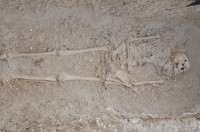 Five late Roman-era skeletons unearthed at the site of an ancient villa near Blandford in North Dorset may be the first owners of a Roman villa ever found in Britain. The team of archaeologists and 85 students from Bournemouth University excavated the villa on a corn field near Winterbourne Kingston last year. This year they did a geophysical survey of the grounds using electrical resistance meters to map archaeological features beneath the earth and found a grave site 300 feet away from the building. Excavation revealed the individual burials of five people: two adult males, two adult females and one elderly females.
Five late Roman-era skeletons unearthed at the site of an ancient villa near Blandford in North Dorset may be the first owners of a Roman villa ever found in Britain. The team of archaeologists and 85 students from Bournemouth University excavated the villa on a corn field near Winterbourne Kingston last year. This year they did a geophysical survey of the grounds using electrical resistance meters to map archaeological features beneath the earth and found a grave site 300 feet away from the building. Excavation revealed the individual burials of five people: two adult males, two adult females and one elderly females.
 The remains date to the 4th century (around 350 A.D.), the same period when the villa was built. Researchers believe the remains represent three generations of the family who owned the villa. Even though many Roman villas have been unearthed in England, most of them were discovered in the 19th century when archaeological practices and technologies were still artifact-focused. Human remains were poorly documented or ignored altogether, thus there is much we don’t know about the landowning elite of late Roman Britain.
The remains date to the 4th century (around 350 A.D.), the same period when the villa was built. Researchers believe the remains represent three generations of the family who owned the villa. Even though many Roman villas have been unearthed in England, most of them were discovered in the 19th century when archaeological practices and technologies were still artifact-focused. Human remains were poorly documented or ignored altogether, thus there is much we don’t know about the landowning elite of late Roman Britain.
The bones have been removed and sent to laboratory for testing that will hopefully narrow down the date and fill in many blanks about the people who lived in the villa.
Miles Russell, a Senior Lecturer in Archaeology at Bournemouth University and one of the archaeologists leading the dig, said, “The discovery is of great significance as it is the only time where evidence of a villa and the villa’s occupants have been found in the same location in Britain. This could provide us with significant information, never retrieved before, about the state of health of the villa owners, their ancestry and where they came from.”
Miles continued, “One of the big questions in South West is whether the villas in the South West were owned by Britons who have become Roman or owned by people from another part of the Empire who have come to exploit an under-developed rural area. All villas in this region in the South West are late-Roman – and our findings should tell us more about what life was like in this period of history. This is what can be assessed when the bones are analysed.”
 The period was a turbulent one, characterized by political upheaval, economic decline, military dissension and increasing Saxon incursions. Britain supported the usurper emperor Magnentius (reigned 350-353 A.D.), and it suffered the displeasure of the legitimate emperor Constantius II after Magnetius was defeated and killed. Magnetius’ supporters in Britain were hunted down and killed by Constantius II’s envoy.
The period was a turbulent one, characterized by political upheaval, economic decline, military dissension and increasing Saxon incursions. Britain supported the usurper emperor Magnentius (reigned 350-353 A.D.), and it suffered the displeasure of the legitimate emperor Constantius II after Magnetius was defeated and killed. Magnetius’ supporters in Britain were hunted down and killed by Constantius II’s envoy.
Ten years later, the Barbarian Conspiracy saw masses of Saxons, Scotti, Picts, Attacotti join with some native Britons and rebellion legions on Hadrian’s Wall ravage the province. They were defeated by general Flavius Theodosius, father of the future emperor Theodosius I, in 368. Meanwhile, the minting of new coins all but stopped by the end of the century. Getting a richer understanding of the occupants of a Roman villa during this era will open a window on how the elites lived when all this was happening around them.
If you’re fortunate enough to be in the neighborhood this weekend, the dig will be hosting an Open Day this Sunday July 13th from 10:30 AM to 4:30 PM. There is no fee and you don’t have to register. Visitors will get a guided tour of the site, a chance to meet the team and to see some of the artifacts that have been excavated this year.
For the less fortunate rest of us, we can follow the Durotriges Project dig on their outstanding Twitter account which is very active and crammed with great pictures.